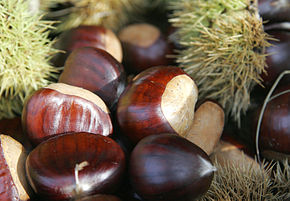
Back Fruito seco AN الفواكه الجافة Arabic جوز كالانرى ARZ Frutu secu AST Fruita seca Catalan Ξηροί καρποί Greek Sekigita frukto Esperanto Fruto seco Spanish Fruitu lehor Basque Fruit sec French


A nut is a fruit consisting of a hard or tough nutshell protecting a kernel which is usually edible. In general usage and in a culinary sense, many dry seeds are called nuts. In a botanical context, "nut" implies that the shell does not open to release the seed (indehiscent).[1]
Most seeds come from fruits that naturally free themselves from the shell, but this is not the case in nuts such as hazelnuts, chestnuts, and acorns, which have hard shell walls and originate from a compound ovary. The general and original usage of the term is less restrictive, and many nuts (in the culinary sense), such as almonds, pistachios, and Brazil nuts,[2] are not nuts in a botanical sense. Common usage of the term often refers to any hard-walled, edible kernel as a nut.[3] Nuts are an energy-dense and nutrient-rich food source.[4]
- ^ "Nut: Plant reproductive body". Encyclopedia Britannica. 6 June 2024. Retrieved 1 July 2024.
- ^ Alasalvar, Cesarettin; Shahidi, Fereidoon (17 December 2008). Tree Nuts: Composition, Phytochemicals, and Health Effects (Nutraceutical Science and Technology). CRC. p. 143. ISBN 978-0-8493-3735-2.
- ^ Black, Michael H.; Halmer, Peter (2006). The encyclopedia of seeds: science, technology and uses. Wallingford, UK: CABI. p. 228. ISBN 978-0-85199-723-0.
- ^ "Nuts". Micronutrient Information Center, Linus Pauling Institute, Oregon State University, Corvallis, OR. 1 September 2018. Archived from the original on 28 March 2019. Retrieved 28 March 2019.